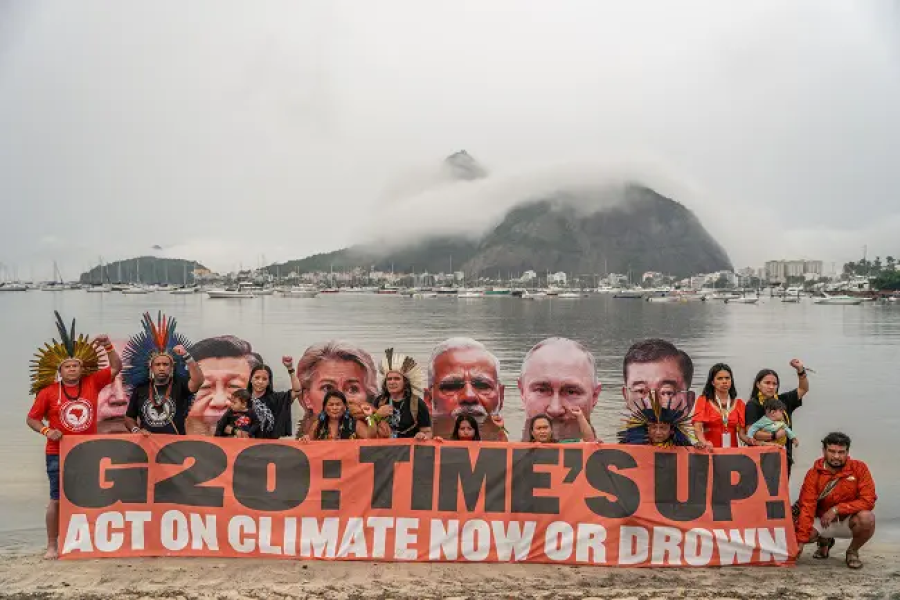Since 1980, more than 50 percent of Cultural Survival's limited funds have supported field projects among indigenous peoples and similarly disadvantaged ethnic groups in the Third World. The final Cultural Survival Quarterly of each year includes a brief description of Cultural Survival's approach to projects and project selection as well as the projects funded during the year.
How Projects Have Been Selected
Rather than designing projects, Cultural Survival responds to requests from either indigenous communities or their regional organizations or support groups. But our budget permits us to support only a few of the requests received. To use our funds most effectively, we select projects that (1) address representative problems faced by small societies in many areas and (2) allow for extensive documentation and analysis.
By confronting common problems we can respond to a few groups' urgent needs and, at the same time, generate case studies useful in developing methodology and theory for aid to other populations. Cultural Survival has also provided emergency assistance, such as medical supplies and travel funds to support research during periods of extreme violations of human rights.
Cultural Survival cannot hope to feed the hungry or support community development worldwide; we have neither the financial nor the human resources to undertake such activities. Our focus has been to help indigenous peoples to help themselves in a variety of ways - supporting their organizations, helping them secure title to their lands and supporting and advising them on questions of resource management and economic development. Above all, we share our knowledge of indigenous peoples' efforts to solve their own problems, gleaned from our research and from the results of our own projects.
Cultural Survival's field projects develop from a definition of the term culture as a set of social mechanisms that gives a society its identity and allows it to comprehend its place in the world and to adapt to changing circumstances. This definition does not imply the preservation of some romantic status quo, but rather supports those mechanisms that permit a group to successfully adapt to change. Cultural Survival takes the position that societies do change and that it is not for outsiders to determine whether indigenous people are being "true to themselves." The organization responds to the needs expressed by native peoples themselves, not to some outsider's idealized image of an appropriate life. These ideas are consistent with the aspirations and demands of native peoples throughout the world. Most want neither their lands nor themselves "frozen" from change and development.
What Is a Representative Problem?
Physical decimation - either from murder, induced famine or introduced diseases - threatens numerous distinct indigenous populations; it sparks justified outrage and demands immediate action in the form of denunciation or international intervention and monitoring. Such gross violations of human rights usually cannot be confronted by field projects. Nevertheless, local development projects serve a vital function by preventing some atrocities. Genocide or other extreme human rights violations often occurs after a long process of gradual social erosion and economic marginalization, a process that weakens a population's ability to defend itself as a group. Terms such as assimilation and integration usually only mask, and thus make more palatable, the destruction of the social fabric that binds a group, provides it with a voice and permits an integrated program for controlling its future.
Cultural Survival's complementary program of field projects and research grew from observations that small societies often become victims during periods of change through exclusion, not through inability or unwillingness to change. Field projects generally assist groups that anticipate or are undergoing radical social change and thus are at critical crossroads in their social and economic evolution. Projects are selected that maximize such groups' control over economic and social variables and permit them the flexibility and means to help prevent their becoming marginalized victims.
This issue of CSQ includes projects supported during 1988 along with the issue of the quarterly in which they were most thoroughly described. Anyone wishing additional information on a particular project can consult past issues of the quarterly or contact Cultural Survival with questions.
Project Evaluations
During 1987, Cultural Survival obtained the services of independent specialists to conduct evaluations of many field projects. Most evaluators normally focus on the utilization of funds provided by the donor agency to a group in the field. Such a limited concept of evaluation, however, would not satisfy Cultural Survival's needs nor accurately reflect its aims. The support provided by Cultural Survival-particularly assistance to regional Indian organizations (ethnic federations) - often did not fund entire or discrete "projects." Cultural Survival's contributions have generally supported a single segment of a group's overall program.
In each case, however, Cultural Survival's concern is with the entire organization, its program and the projects that program creates. As such, Cultural Survival's "evaluations" are better understood as case studies that illustrate examples and patterns of self-directed development.
Current and Future Projects
Based on the encouraging results of the 1987 evaluations, the overall philosophy of Cultural Survival's approach to projects will remain unchanged. As indicated by the listing of projects which follows, the organization has supported a wide range of activities both through direct support and "special projects" (i.e., those that are sponsored by Cultural Survival but generate their own funding). Commitment to such programs will continue. However, in response to critical challenges now facing indigenous people, Cultural Survival will focus attention on the following related activities:
Support for Representative Indigenous Ethnic Federations
Ethnic federations are becoming an increasingly effective voice for indigenous peoples throughout the world. During the last two decades, such organizations have formed in every country in Latin America. In the past, Indians were excluded from development plans that affected them; representative Indian federations can now challenge this marginalization of indigenous peoples in the national sphere. These organizations were initially formed at the grassroots level to address local threats or needs; Indian leaders soon discovered that the dispersed indigenous communities often faced the same problems and challenges. Thus local organizations joined to create ethnic and pan-ethnic federations.
Such mobilization was, and for many still remains, an essential first step toward the empowerment of indigenous peoples. Cultural Survival will continue to support such work. However, to maximize their strength, ethnic federations must both protect Indian rights and resources and provide opportunities for economic improvement in indigenous communities. It is within this context that numerous ethnic federations now seek to design and implement programs of rational resource management.
Development of Sustainable Resource Management Programs
Indigenous peoples fully recognize that the quality of their existence - present and future - is linked to the issue of land rights and control. Obtaining legal title is a vital step toward gaining control of traditional lands. De facto control, however, is often won through aggressive exploitation of a region's natural resources. Lands not under active cultivation become easy targets for legal or extra-legal expropriation. Lack of land tenure security in many areas has encouraged ecologically destructive competition between indigenous people and colonists, agribusinesses, and other economic interests. In this sense, the notion of "fragile lands" connotes a political as well as physical environment.
Development of sustainable resource management programs benefits indigenous communities in numerous ways. First, such programs strengthen their land tenure status by demonstrating gainful use of the land. Second, these programs can provide ongoing economic opportunities to the communities. Third, rational resource management offers a way to preserve and sustain their lands.
Cultural Survival's work with indigenous federations in the area of resource management demonstrates a potential convergence of interest between such groups and national governments and environmentalists - a convergence that in the past has proven elusive. Cultural Survival aims to strengthen the federations and thus encourage a more healthy interaction between indigenous peoples, national governments and other organizations. The focus of specific projects will be determined through collaborative planning with indigenous federations.
This work is a regional pilot project; most of the activities described here are in Latin America. However, Cultural Survival plans to adapt the knowledge gained from the implementation of this program for similarly affected areas of Africa, Asia and the Pacific. The following examples illustrate the potential nature and scope of future resource management activities:
The Awa Indian/Forest Reserve
On 13 September 1988, the Ecuadorian government formally constituted the 140,000-ha "Awa Indian/Forest Reserve." This formal titling marks the successful culmination of a key phase in an unprecedented international program combining the goals of Indian land rights, sustainable economic development and land conservation.
Traditional Awa lands span a remote region of the Ecuadorian-Colombian border. Prior to 1980, their isolation provided the Awa with a fragile autonomy. In the early 1980s, however, proposed road construction and an influx of Colombian miners crossing the ill-defined border disrupted their delicate independence. Uneasy about border region instability, the Ecuadorian government formed the Inter-Institutional Tobar Donoso Commission in 1982 to examine possibilities for regional development and integration. The commission elaborated a set of three goals for the area: incorporation of the regional population in the national economy, expansion of the agricultural frontier and protection of the Awa culture.
Cultural Survival, which sponsored preliminary Awa land studies in 1980, was requested by the inter-institutional commission to fund additional studies to delimit Indian lands. These funds are channeled by Cultural Survival through the national Indian organization, CONAIE - a decision which was to have great impact on the future success of the program. In this way, the national Indian federation, as a direct member of the commission, was incorporated in program planning from the start. Such collaboration between an Indian organization and the national government was unprecedented. This cooperation served the interests of both CONAIE, which gained in national status by disbursing project funds, and the national government, which gained new regional support.
Botanical surveys undertaken at this time revealed the unique environmental characteristics of the Awa territory. These tropical forest lands, considered an ecological "refuge zone," had suffered little disturbance and thus harbored a wide variety of species specific to the area. This discovery generated requests to declare the area a forest reserve. Indians initially rejected the proposal for a reserve, insisting that lands be titled directly to the Awa. Experiences in other areas had demonstrated the fragile tenure of reserve lands. A satisfactory compromise was reached by the indigenous federations and the government by establishing a joint forest and Indian reserve through unique legislation which defined the Awa Indian/Forest Reserve.
Preliminary achievements in the area include: political organization of the Awa people (previously one of the least-organized ethnic groups in Ecuador), granting of national identity papers to the Indian population, and compensated removal of colonists from the region.
The early successes of the Ecuadorian Awa initiative spurred the Colombian government to consider similar plans for Awa territory in Colombia. Colombian plans call for the creation of an 800,000-ha reserve area. In addition, since 1986, the Ecuadorian and Colombian governments have conducted bilateral meetings to elaborate a coherent set of resource management plans for the bi-national Awa region. This formal recognition by national governments of the cultural and physical continuity of an ethnic group and an environment across national borders is unprecedented. Collaboration has proven beneficial for governments and Indians of both countries - Colombia provides the technical resources through La Planada, an environmental research station located in Colombian Awa territory, and Ecuador offers the organizational experience necessary for the successful implementation of such an initiative.
Application has been made to UNESCO's Man in the Biosphere program to create a biosphere reserve in the area. Land use will vary according to the nature of the terrain - pristine areas will be reserved for scientific study and "ecotourism," and other lands can be used for sustainable agriculture and forestry. Exposure to such land use systems through an Inter-American Foundation-supported 10-day visit to the Kuna Indians' Project Pemasky took place in September. A subsequent visit to Ecuador by the Kuna is planned for early 1989.
The Awa case demonstrates the potential of active participation of indigenous federations in the elaboration of resource management programs. Though much remains to be accomplished, the broad program gains are impressive thus far: political organization of Indians, both the Awa themselves, and the bolstering of status of the national Indian federation, CONAIE; direct involvement in environmental planning; increased level of communication and cooperation between national government and Indian federations; and a high level of cooperation between Colombia and Ecuador.
FOIN Resource Management Program
In March 1987, an earthquake destroyed the sole road providing access from Quito to the Coca/Lago Agrio region of northern Ecuador. The Ecuadorian government hastily constructed an alternate road through relatively pristine tropical forest lands in Quichua-titled territory. This new road threatens both the physical and political integrity of these extremely fragile lands and those who inhabit them. In defensive and preemptory action, Quichua Indians began to cut down their forest adjacent to the new road and sell the timber to encroaching forestry concerns. If left unchecked, this will lead to severe deforestation with little economic gain by Indians.
Cultural Survival, in collaboration with FOIN, the regional Indian federation, has initiated a program to confront the threats posed by this road. The program has two phases: first, and most immediately, to halt destructive logging practices, and second, and more long term, to develop regional plans for sustainable resource management.
The first stage of the project involved training Indians to undertake land use studies and to survey land tenure status in the affected areas. Through these studies it was discovered that tenure is often precarious and that the selling of timber is extensive and non-lucrative. The federation then acted to ensure legal land title for the indigenous population and to inform them as to the destructive nature of current logging practices.
The second phase of the program involves a program of natural resource management. Cultural Survival's role in the development of these plans is twofold. First, Cultural Survival will present Quichua leaders with natural resource management options. This will be accomplished through visits to various Indian-managed projects such as those operated by the Kuna of Panama, the Amuesha of Peru and the Awa of Colombia and Ecuador. Once the Quichua are aware of development alternatives, they can make a more informed choice as to what best suits the needs of the community and the capabilities of the land. Cultural Survival will then work with the Indian federations to obtain funding and assistance necessary to convert the project plan into reality. The overall goal is a regional, Indian-managed resource management program that ranges from conservation, to natural forest management, to agroforestry.
Article copyright Cultural Survival, Inc.



